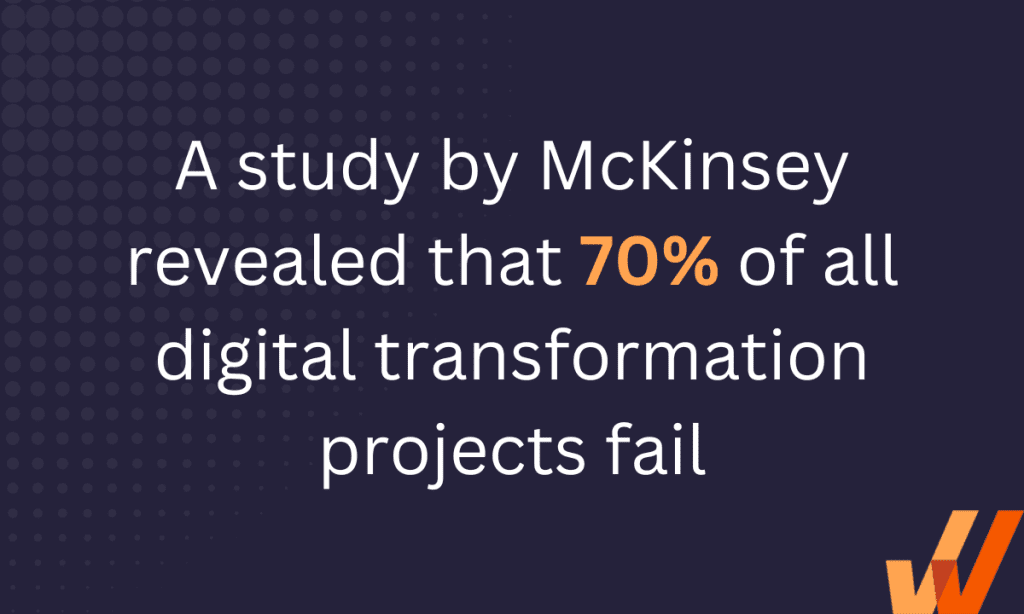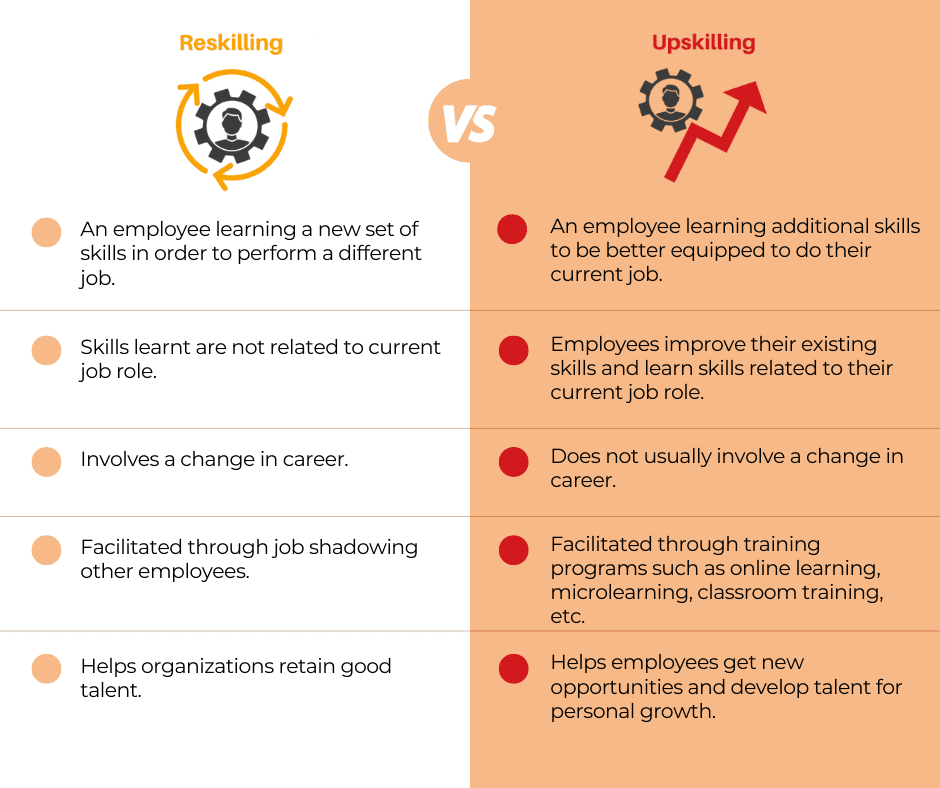
Samantha Rohn


Imagine investing millions in a new digital initiative, only to watch it crumble. Sounds devastating, right? Yet, 70% of digital transformation projects end this way.
These projects exceed budget, fail to meet their basic goals, drag on continually, or experience a combination of these digital transformation challenges.
At first glance, you might assume it’s just poor planning and a culture of resistance to change that hinders digital transformation. But even some of the biggest, most visionary companies have witnessed embarrassing transformation failures that had several similar issues.
Whether you’re a CIO, department manager, or IT adminstrator, understanding the downfalls of digital transformation is crucial to safeguard your projects.
This article will dive into the key reasons why digital transformation projects fail, touching on several corporate examples, as well as how you can ensure success in your digital transformation efforts.
Digital transformation is the process of using digital technologies to transform existing traditional and non-digital business processes and services, or creating new ones, to meet the evolving market and customer expectations, thus completely altering the way businesses are managed and operated, and how value is delivered to customers.

Digital transformation initiatives may fail for many reasons, but the most common causes include the following:
One of the biggest reasons digital transformation fails is because it never had a chance to do otherwise.
Many times, it’s imagined as a vanity project that’ll make a company look visionary, futuristic, and positive.
In other words, digital transformation initiatives are often solutions looking for a problem to solve, and as a result, there are no clear goals set to guide them. This leads to a situation where a company ships new tech for its sake but doesn’t have metrics for measuring success. The project drags on, goes over budget, and eventually shutters when it’s subjected to scrutiny.
Different departments or levels in an organization may also have different digital transformation goals. For instance:
In such a situation where there’s no shared vision, it might be hard to get funding, feedback, or to commit departments to do their bit to make a digital transformation initiative successful.
A change management strategy helps you determine how your day-to-day operations will run when rolling out a new piece of technology.
Whether it’s a new CRM, ERP transformation, or even another email provider you’re switching to, a change management strategy explains how operations will run until the migration is completed successfully.
Many companies also often set an accelerated timeline for a digital transformation project that’s shorter than what their implementation partners and advisors suggest.
As a result, they cut corners on some of the critical steps required to switch to different IT solutions because the leadership doesn’t understand the technical legwork needed to successfully migrate to a new platform.

Recent studies show that 40-50% of salespeople don’t use their CRMs. Even when they do, 76% of sales leaders report that their teams never use most of the functionality offered due to internal resistance to change.
This is not a problem that’s unique to sales– it also applies to marketing, business development, design, etc.
Oftentimes, employees think the systems they’ve honed on their own are more trustworthy than another piece of software. Likewise, they may not have the knowledge needed to use a new tool as efficiently and may opt to shelf it, at least for the meantime.
On the flip side, a situation may arise where junior levels in an organization see the need for a new solution that works better than what they have. As a result, they try to petition the leadership for a new solution. They’re often denied, and even if the project is begrudgingly approved, it doesn’t get the funding, guidance, and operational support required to make it successful across the entire organization.
Pro tip: If you’re not part of your company’s leadership team, getting buy-in from those above can either make or break your digital transformation ideas since that’s where the momentum will either come from or get turned off from.
Some older systems might not integrate well with newer technologies or might require complex workarounds, slowing down the transformation process. This misalignment may necessitate complicated workarounds or custom solutions to bridge the technology gap, slowing down transformation initiatives.
Moreover, maintaining these systems becomes more challenging and costly as they age, primarily due to a dwindling pool of experts familiar with their intricacies and the discontinuation of necessary hardware components or updates.
Not thoroughly testing new systems or processes can also lead to significant operational issues when rolled out. When new systems or processes aren’t rigorously tested, they can lead to unforeseen complications upon rollout. Such inadequacies can disrupt regular operations, sometimes with significant financial implications due to post-deployment troubleshooting.
When these untested systems interface directly with customers, any glitches or inefficiencies can tarnish a company’s reputation.

When embarking on the path of digital transformation, it’s crucial for businesses to ensure their strategies are tailored to their unique operational needs and not merely reactive responses to market competitors. While it’s natural for companies to closely monitor industry giants and competitors, blindly emulating their digital initiatives can be counterproductive.
In a hurried bid to play catch-up after a competitor announces a significant digital launch, executives might hastily draft a digital transformation model without clearly understanding the solution’s purpose, functionality, and associated costs. This lack of introspection and misaligned prioritization can lead to misallocated resources and strategic blunders.
Digital transformation is an intricate process that should be rooted in a company’s specific goals, strengths, and challenges. By impulsively mirroring competitors, organizations risk adopting solutions that may be incongruent with their business model or irrelevant to their customer base. Such a misstep can culminate in expensive implementations that offer little value, disrupt functioning processes, and ultimately burden companies with undue complexities and costs. Instead, take a measured approach to digital transformation and consider hiring a digital transformation consulting company to help map your journey.
At the heart of every successful digital transformation initiative lies a paramount goal: to serve customers better and add value to their experiences. Every facet of the digital transformation, from design to implementation, should be anchored in this.
However, a frequent mistake organizations make is neglecting to deeply understand their customer’s expectations and needs. Despite the speed of rollout or efficiency of the adopted technologies, a digital transformation effort that doesn’t resonate with the genuine needs of its customers misses its core objective.
By bypassing this foundational knowledge, organizations risk developing solutions that, while technologically sound, don’t align with what their customers truly value. This not only results in resource misallocation, but can also lead to diminished customer satisfaction and potential revenue setbacks.
Digital transformation isn’t just a technological endeavor; it’s also a human one.
The crux of any digital shift rests heavily on the shoulders of the individuals piloting it. Without sufficient technical knowledge, the transformation can lose its direction and purpose.
But beyond the technological expertise, soft skills play a key role— they act as the glue, ensuring seamless communication and collaboration across different teams and departments.
Without these necessary skills, the success of a digital transformation plan can be jeopardized. Simply implementing advanced technology is meaningless if employees cannot effectively utilize it.
To address this issue, organizations must prioritize digital upskill training for employees as part of their digital transformation roadmap. Comprehensive training programs enhance employees’ technological skills and promote the seamless integration of digital initiatives into the organization.

The dynamic world of digital transformation demands an equally agile organizational approach. Rigidly sticking to predefined plans can become an organization’s Achilles’ heel, especially as the digital landscape constantly evolves. Being able to pivot and adjust strategies is not just a desirable trait but an essential one.
But agility isn’t just about being strategically flexible— it also involves an organization’s ability to allocate resources effectively. Failing to accurately assess the amount of time or finances needed can hinder even the most well-intentioned digital strategies.
And it’s not just about initial implementation; the vision must be scalable, too. A solution that works well in a limited environment may not be able to handle the demands of a larger organization or a growing customer base.
In today’s digital era, data is both an asset and a challenge. It’s the compass guiding digital transformation, offering insights, flagging anomalies, and suggesting refinements. But without a coherent strategy, this data can become overwhelming. An effective data strategy is multifaceted, addressing acquisition, storage, analysis, and management.
The story doesn’t end with data acquisition or analysis— monitoring and measuring the impact of digital initiatives offer a clear lens into their efficacy.
Without these metrics, it’s difficult to navigate the complex waters of digital transformation. Regular metrics-driven reviews can ensure that the transformation remains aligned with organizational goals and continues to deliver value.
Innovation, while commendable, should never come at the expense of security and compliance. As organizations embrace digital solutions, they also expose themselves to a variety of potential cyber threats. Neglecting security can be detrimental, ranging from financial repercussions to irreparable brand damage.
As the digital realm expands, so too does its regulation. These rules and guidelines exist to safeguard those involved, maintain data privacy, and promote ethical digital behavior. Failing to adhere to them can result in legal complications that divert attention from a company’s primary objectives and even result in costly fines.
Achieving digital transformation requires both vision and practicality. Having ambitious goals is important, but setting them too high can be harmful. Unrealistic goals can lead to disappointment and lower morale in your organization, creating a feeling of constant inadequacy. That’s why it’s essential to strike a balance.
By joining ambition with realism, organizations can set themselves on a path where achievements, even if incremental, are recognized and celebrated. This fosters a positive environment, encouraging teams to persevere even when faced with challenges and ensuring that the spirit of transformation remains undiminished.
The biggest companies may be leaders in technology and innovation. But they also have a history of avoidable mistakes, especially when using technology to empower their operations.
Here are six of the most infamous digital transformation failures and how they could have been avoided:
Hershey’s, the renowned multinational brand known for its delectable chocolates and desserts, embarked on a mission to modernize its patchwork of legacy IT systems in 1996. The chosen solutions for this transformation were SAP’s R/3 ERP, Oracle Seibel’s CRM, and Manugistics’ supply chain management system.
With a budget of $112 million, the initial rollout of these new systems was projected to span 48 months. However, in a bid to pre-empt the Y2K dilemma, Hershey’s leadership accelerated the timeline, cutting it down to 30 months. This meant that crucial testing stages were curtailed.
Aggravating the situation, the final implementation was scheduled for July 1999, coinciding with one of Hershey’s peak business periods. The result was catastrophic— systemic issues with the newly implemented ERP led to a failure to fulfill orders worth over $100 million, even though the required inventory was available. This debacle had huge financial repercussions, leading to a 19% decline in quarterly revenues and an 8% dip in the company’s stock value.
What can be learned from this?
HP, recognized as one of the leading PC vendors with its emblematic logo adorning numerous laptops, desktops, and peripherals, has faced challenges during its growth trajectory. A notable challenge emerged in 2003 when HP aimed to streamline its IT systems into a single, unified ERP, choosing SAP for the task.
The leadership, somewhat optimistically, anticipated a short three-week window to address any IT challenges post-migration. This forecast proved to be hugely miscalculated.
The new ERP didn’t integrate well with HP’s legacy systems, leading to a massive 20% of server orders going unfulfilled and resulting in a logistical nightmare with accumulating shipments. This mishap was further compounded by the lack of manual backup processes to bypass the ERP for shipping orders.
HP’s oversight in adequately investing in change management became apparent as they grappled with unforeseen challenges without clear backup strategies. Ultimately, this transformation project inflicted a staggering $160 million blow to HP, culminating in lost revenue and backlogged orders.
What can be learned from this?
In 2013, the renowned alcoholic beverage giant, MillerCoors, embarked on an ambitious ERP implementation venture with hopes of accelerating procurement, enhancing accounting practices, and streamlining supply chain operations.
The project, with an investment nearing $100 million, lingered for three years without any substantial progress. Eventually, the company severed its ties with the implementing partner and resorted to legal action against them.
Reflecting on the setbacks, it became clear that MillerCoors could have taken several measures to enhance the outcome. A more meticulous approach to defining expectations and requirements, a better-informed decision in selecting an experienced partner for the beverage sector, and bolstering the project with internal oversight and guidance might have helped avoid the costly and time-consuming debacle.
What can be learned from this?
In February 2018, cosmetics giant Revlon initiated the rollout of a new ERP system. However, the migration was spoiled by inadequate planning, severely disrupting their production line and hampering their ability to fulfill customer orders promptly. This ill-prepared ERP rollout wasn’t an isolated issue; it had been prematurely introduced across operations in 22 countries.
The aftermath of this implementation was financially catastrophic. The company grappled with a staggering $64 million loss due to unshipped orders. In tandem with operational disruptions, investor confidence wavered, leading to a 6.9% plunge in Revlon’s stock price. This operational debacle culminated in a lawsuit, with investors seeking redress for the significant financial damages they endured due to the company’s underperformance.
What can be learned from this?
In 2011, GE embarked on an ambitious digital journey, aspiring to establish itself among the “top 10 software companies” by the end of the decade. Central to their strategy was a significant investment in the field of the Internet of Things, with their proprietary platform, Predix, at the forefront.
By the time 2017 rolled around, GE was struggling with unmet objectives and technical glitches. Barely a year later, the conglomerate found itself retreating from its lofty digital aspirations. They registered a staggering write-off of $22 billion and partitioned their digital holdings into an independent entity.
What can be learned from this?
Digital transformation in the automotive industry can be tricky. In the dawn of the 21st century, automotive giant Ford embarked on an ambitious journey to rejuvenate its purchasing system. This endeavor, aptly named Everest, aimed to usher in modernity to Ford’s procurement and supply chain operations, with a projected timeline of five years and a budget set at $200 million. However, as the project unfolded, flaws in its design and execution became glaringly evident.
Despite the initial enthusiasm and investment, Everest was eventually shelved. This venture not only failed to meet its objectives, but also inflicted a financial wound on Ford, with losses doubling the initial budget to an estimated $400 million.
What can be learned from this?
Rolling out a new piece of software is just half the work.
It’s crucial to engage the human factor and train your end-users within your organization to make the most of your new tech product – otherwise, it’ll end up as yet another piece of shelfware that no one uses.
Whatfix helps companies speed up adoption with guided onboarding designed to teach users on a case-by-case basis. The digital adoption platform (DAP) offers contextual assistance with documents, walkthrough videos, and tips that your employees can access right inside the applications they work with.
Don’t be part of the 70% whose digital transformations fail. Equip your team with Whatfix and ensure successful onboarding. Start your transformation journey with Whatfix today.

Thank you for subscribing!